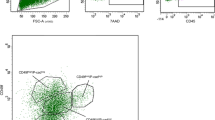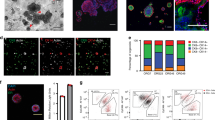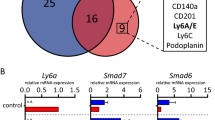Abstract
The mammary epithelium is composed of several cell lineages including luminal, alveolar and myoepithelial cells. Transplantation studies have suggested that the mammary epithelium is maintained by the presence of multipotent mammary stem cells. To define the cellular hierarchy of the mammary gland during physiological conditions, we performed genetic lineage-tracing experiments and clonal analysis of the mouse mammary gland during development, adulthood and pregnancy. We found that in postnatal unperturbed mammary gland, both luminal and myoepithelial lineages contain long-lived unipotent stem cells that display extensive renewing capacities, as demonstrated by their ability to clonally expand during morphogenesis and adult life as well as undergo massive expansion during several cycles of pregnancy. The demonstration that the mammary gland contains different types of long-lived stem cells has profound implications for our understanding of mammary gland physiology and will be instrumental in unravelling the cells at the origin of breast cancers.
This is a preview of subscription content, access via your institution
Access options
Subscribe to this journal
Receive 51 print issues and online access
$199.00 per year
only $3.90 per issue
Buy this article
- Purchase on Springer Link
- Instant access to full article PDF
Prices may be subject to local taxes which are calculated during checkout





Similar content being viewed by others
References
Watson, C. J. & Khaled, W. T. Mammary development in the embryo and adult: a journey of morphogenesis and commitment. Development 135, 995–1003 (2008)
Smalley, M. & Ashworth, A. Stem cells and breast cancer: A field in transit. Nature Rev. Cancer 3, 832–844 (2003)
Visvader, J. E. Keeping abreast of the mammary epithelial hierarchy and breast tumorigenesis. Genes Dev. 23, 2563–2577 (2009)
Visvader, J. E. & Smith, G. H. Murine mammary epithelial stem cells: Discovery, function, and current status. Cold Spring Harb. Perspect. Biol. 3, 1–14 (2011)
Stingl, J. Detection and analysis of mammary gland stem cells. J. Pathol. 217, 229–241 (2009)
Pechoux, C., Gudjonsson, T., Ronnov-Jessen, L., Bissell, M. J. & Petersen, O. W. Human mammary luminal epithelial cells contain progenitors to myoepithelial cells. Dev. Biol. 206, 88–99 (1999)
Stingl, J., Eaves, C. J., Kuusk, U. & Emerman, J. T. Phenotypic and functional characterization in vitro of a multipotent epithelial cell present in the normal adult human breast. Differentiation 63, 201–213 (1998)
Gudjonsson, T. et al. Isolation, immortalization, and characterization of a human breast epithelial cell line with stem cell properties. Genes Dev. 16, 693–706 (2002)
Dontu, G. et al. In vitro propagation and transcriptional profiling of human mammary stem/progenitor cells. Genes Dev. 17, 1253–1270 (2003)
Kordon, E. C. & Smith, G. H. An entire functional mammary gland may comprise the progeny from a single cell. Development 125, 1921–1930 (1998)
Smith, G. H. Experimental mammary epithelial morphogenesis in an in vivo model: evidence for distinct cellular progenitors of the ductal and lobular phenotype. Breast Cancer Res. Treat. 39, 21–31 (1996)
Stingl, J. et al. Purification and unique properties of mammary epithelial stem cells. Nature 439, 993–997 (2006)
Shackleton, M. et al. Generation of a functional mammary gland from a single stem cell. Nature 439, 84–88 (2006)
Blanpain, C. & Fuchs, E. Epidermal homeostasis: a balancing act of stem cells in the skin. Nature Rev. Mol. Cell Biol. 10, 207–217 (2009)
Sleeman, K. E., Kendrick, H., Ashworth, A., Isacke, C. M. & Smalley, M. J. CD24 staining of mouse mammary gland cells defines luminal epithelial, myoepithelial/basal and non-epithelial cells. Breast Cancer Res. 8, R7 (2006)
Lim, E. et al. Transcriptome analyses of mouse and human mammary cell subpopulations reveal multiple conserved genes and pathways. Breast Cancer Res. 12, R21 (2010)
Kendrick, H. et al. Transcriptome analysis of mammary epithelial subpopulations identifies novel determinants of lineage commitment and cell fate. BMC Genomics 9, 591 (2008)
Barker, N. et al. Identification of stem cells in small intestine and colon by marker gene Lgr5. Nature 449, 1003–1007 (2007)
Wagner, K. U. et al. An adjunct mammary epithelial cell population in parous females: its role in functional adaptation and tissue renewal. Development 129, 1377–1386 (2002)
Booth, B. W., Boulanger, C. A. & Smith, G. H. Alveolar progenitor cells develop in mouse mammary glands independent of pregnancy and lactation. J. Cell. Physiol. 212, 729–736 (2007)
Chepko, G. & Smith, G. H. Three division-competent, structurally-distinct cell populations contribute to murine mammary epithelial renewal. Tissue Cell 29, 239–253 (1997)
Rudland, P. S. & Hughes, C. M. Immunocytochemical identification of cell types in human mammary gland: variations in cellular markers are dependent on glandular topography and differentiation. J. Histochem. Cytochem. 37, 1087–1100 (1989)
Fernandez-Gonzalez, R. et al. Mapping mammary gland architecture using multi-scale in situ analysis. Integr. Biol. 1, 80–89 (2009)
Van Keymeulen, A. et al. Epidermal progenitors give rise to Merkel cells during embryonic development and adult homeostasis. J. Cell Biol. 187, 91–100 (2009)
Liu, X. et al. Somatic loss of BRCA1 and p53 in mice induces mammary tumors with features of human BRCA1-mutated basal-like breast cancer. Proc. Natl Acad. Sci. USA 104, 12111–12116 (2007)
Srinivasan, K., Strickland, P., Valdes, A., Shin, G. C. & Hinck, L. Netrin-1/neogenin interaction stabilizes multipotent progenitor cap cells during mammary gland morphogenesis. Dev. Cell 4, 371–382 (2003)
Naylor, S. et al. Retroviral expression of Wnt-1 and Wnt-7b produces different effects in mouse mammary epithelium. J. Cell Sci. 113, 2129–2138 (2000)
Welm, B. E. et al. Sca-1pos cells in the mouse mammary gland represent an enriched progenitor cell population. Dev. Biol. 245, 42–56 (2002)
Welm, B. E., Dijkgraaf, G. J., Bledau, A. S., Welm, A. L. & Werb, Z. Lentiviral transduction of mammary stem cells for analysis of gene function during development and cancer. Cell Stem Cell 2, 90–102 (2008)
Tsai, Y. C. et al. Contiguous patches of normal human mammary epithelium derived from a single stem cell: implications for breast carcinogenesis. Cancer Res. 56, 402–404 (1996)
Badders, N. M. et al. The Wnt receptor, Lrp5, is expressed by mouse mammary stem cells and is required to maintain the basal lineage. PLoS ONE 4, e6594 (2009)
Taddei, I. et al. β1 integrin deletion from the basal compartment of the mammary epithelium affects stem cells. Nature Cell Biol. 10, 716–722 (2008)
Srinivas, S. et al. Cre reporter strains produced by targeted insertion of EYFP and ECFP into the ROSA26 locus. BMC Dev. Biol. 1, 4 (2001)
Madisen, L. et al. A robust and high-throughput Cre reporting and characterization system for the whole mouse brain. Nature Neurosci. 13, 133–140 (2010)
Vasioukhin, V., Bauer, C., Degenstein, L., Wise, B. & Fuchs, E. Hyperproliferation and defects in epithelial polarity upon conditional ablation of α-catenin in skin. Cell 104, 605–617 (2001)
Nguyen, H., Rendl, M. & Fuchs, E. Tcf3 governs stem cell features and represses cell fate determination in skin. Cell 127, 171–183 (2006)
Perl, A. K., Wert, S. E., Nagy, A., Lobe, C. G. & Whitsett, J. A. Early restriction of peripheral and proximal cell lineages during formation of the lung. Proc. Natl Acad. Sci. USA 99, 10482–10487 (2002)
Acknowledgements
We thank our colleagues who provided us with reagents, which are cited in the text, and B. Hogan for sharing unpublished mice. We thank our colleagues from the Blanpain laboratory and C. Govaerts for their comments on the manuscript. We thank J. Rosen for discussion and M. Van Lohuizen and K. Nacerddine for their help with the transplantation assay. We thank F. Bollet-Quivogne and J.-M. Vanderwinden for their help with confocal imaging. C.B. and A.V.K. are chercheur qualifié, B.B. is chargé de recherche and M.O. is a collaborateur scientifique of the FRS/FNRS. A.S.R. is supported by TELEVIE and the Portuguese Science Foundation (FCT). N.S. is supported by the Fondation Contre le Cancer. J.R. is supported by the grant F32HL102920. C.B. is an investigator of Welbio. This work was supported by the FNRS, TELEVIE, the program d’excellence CIBLES of the Wallonia Region, a research grant from the Fondation Contre le Cancer, the ULB fondation, the fond Gaston Ithier, a starting grant of the European Research Council (ERC) and the EMBO Young Investigator Program.
Author information
Authors and Affiliations
Contributions
C.B., A.V.K, A.S.R. designed the experiments and performed data analysis. AV.K., A.S.R. and M.O. performed most of the experiments, J.R. generated the K5-CreER knockin mice, B.B., S.D. and A.V.K. performed the FACS analysis and cell sorting. G.B. and N.S. provided technical support. C.B. wrote the manuscript.
Corresponding author
Ethics declarations
Competing interests
The authors declare no competing financial interests.
Supplementary information
Supplementary Information
The file contains Supplementary Figures 1-32 with legends and Supplementary Table 1. (PDF 2538 kb)
Rights and permissions
About this article
Cite this article
Van Keymeulen, A., Rocha, A., Ousset, M. et al. Distinct stem cells contribute to mammary gland development and maintenance. Nature 479, 189–193 (2011). https://doi.org/10.1038/nature10573
Received:
Accepted:
Published:
Issue Date:
DOI: https://doi.org/10.1038/nature10573
This article is cited by
-
Sexual dimorphism in melanocyte stem cell behavior reveals combinational therapeutic strategies for cutaneous repigmentation
Nature Communications (2024)
-
Comprehensive Review on the Effect of Stem Cells in Cancer Progression
Current Tissue Microenvironment Reports (2024)
-
Using Organoids to Tap Mammary Gland Diversity for Novel Insight
Journal of Mammary Gland Biology and Neoplasia (2024)
-
Progesterone from ovulatory menstrual cycles is an important cause of breast cancer
Breast Cancer Research (2023)
-
Epithelial plasticity enhances regeneration of committed taste receptor cells following nerve injury
Experimental & Molecular Medicine (2023)
Comments
By submitting a comment you agree to abide by our Terms and Community Guidelines. If you find something abusive or that does not comply with our terms or guidelines please flag it as inappropriate.



